.
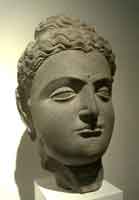
Gandhara Buddha, 1st-2nd century AD
Greco-Buddhist art is the artistic manifestation of Greco-Buddhism, a cultural syncretism between the Classical Greek culture and Buddhism, which developed over a period of close to 1000 years in Central Asia, between the conquests of Alexander the Great in the 4th century BC, and the Islamic conquests of the 7th century AD. Greco-Buddhist art is characterized by the strong idealistic realism of Hellenistic art and the first representations of the Buddha in human form, which have helped define the artistic (and particularly, sculptural) canon for Buddhist art throughout the Asian continent up to the present. It is also a unique example of cultural syncretism between eastern and western traditions, which has been achieved by no other art to such a degree.
The origins of Greco-Buddhist art are to be found in the Hellenistic Greco-Bactrian kingdom (250 BC- 130 BC), located in today’s Afghanistan, from which Hellenistic culture radiated into the Indian sub-continent with the establishment of the Indo-Greek kingdom (180 BC-10 BC). Under the Indo-Greeks and then the Kushans, the interaction of Greek and Buddhist culture flourished in the area of Gandhara, in today’s northern Pakistan, before spreading further into India, influencing the art of Mathura, and then the Buddhist art of the Gupta empire, which was to extend to the rest of South-East Asia. The influence of Greco-Buddhist art also spread northward towards Central Asia, strongly affecting the art of the Tarim Basin at the door of China, and ultimately the arts of China, Korea, and Japan.
Hellenistic art in southern Asia
Powerful Hellenistic states were established in the areas of Bactria and Sogdiana, and later northern India for three centuries following the conquests of Alexander the Great around 330 BC: the Seleucid empire until 250 BC, followed by the Greco-Bactrian kingdom until 130 BC, and the Indo-Greek kingdom from 180 BC to around 10 BC.
The clearest examples of Hellenistic art are found in the coins of the Greco-Bactrian kings of the period, such as Demetrius I of Bactria. Many coins of the Greco-Bactrian kings have been unearthed, including the largest silver and gold coins ever minted in the Hellenistic world, ranking among the best in artistic and technical sophistication: they “show a degree of individuality never matched by the often more bland descriptions of their royal contemporaries further West”. (“Greece and the Hellenistic world”).
These Hellenistic kingdoms established cities on the Greek model, such as in Ai-Khanoum in Bactria, displaying purely Hellenistic architectural features, Hellenistic statuary, and remains of Aristotelician papyrus prints and coin hoards.
These Greek elements penetrated in northwestern India following the invasion of the Greco-Bactrians in 180 BC, when they established the Indo-Greek kingdom in India. Fortified Greek cities, such as Sirkap in northern Pakistan, were established. Architectural styles used Hellenistic decorative motifs such as fruit garland and scrolls. Stone palettes for aromatic oils representing purely Hellenistic themes such as a Nereid riding a Ketos sea monster are found.
In Hadda, Hellenistic deities, such as Atlas are found. Wind gods are depicted, which will affect the representation of wind deities as far as Japan. Dyonisiac scenes represent people in Classical style drinking wine from amphoras and playing instruments.
Greco-Buddhist artistic interaction
As soon as the Greeks invaded India to form the Indo-Greek kingdom, a fusion of Hellenistic and Buddhist elements started to appear, encouraged by the benevolence of the Greek kings towards Buddhism. This artistic trend then developed for several centuries and seemed to flourish further during the Kushan Empire from the first century AD.
Artistic model
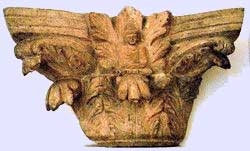
An Indo-Corinthian capital with the Buddha at its center, 3-4th century, Gandhara.
Greco-Buddhist art depicts the life of the Buddha in a visual manner, probably by incorporating the real-life models and concepts which were available to the artists of the period.
The Bodhisattvas are depicted as bare-chested and jewelled Indian princes, and the Buddhas as Greek kings wearing the light toga-like himation. The buildings in which they are depicted incorporate Greek style, with the ubiquitous Indo-Corinthian capitals and Greek decorative scrolls. Surrounding deities form a pantheon of Greek (Atlas, Herakles) and Indian gods (Indra).
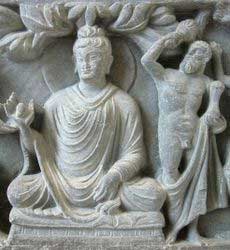
Heracles depiction of Vajrapani as the protector of the Buddha, 2nd century Gandhara, British Museum.
Stylistic evolution
Stylistically, Greco-Buddhist art started by being extremely fine and realistic, as apparent on the standing Buddhas, with "a realistic treatment of the folds and on some even a hint of modelled volume that characterizes the best Greek work" (Boardman). It then lost this sophisticated realism, becoming progressively more symbolic and decorative over the centuries.
Architecture
The presence of stupas at the Greek city of Sirkap, built by Demetrius around 180 BC, already indicates a strong syncretism between Hellenism and the Buddhist faith, together with other religions such as Hinduism and Zoroastrianism. The style is Greek, adorned with Corinthian columns in excellent Hellenistic execution.
Later in Hadda, the Greek divinity Atlas is represented holding Buddhist monuments with decorated Greek columns. The motif was adopted extensively throughout the Indian sub-continent, Atlas being substituted for the Indian Yaksa in the monuments of the Sunga around the 2nd century BC.
The Buddha
Sometime between the 2nd century BC and the 1st century AD, the first anthropomorphic representations of the Buddha were developed. These were absent from earlier strata of Buddhist art, which preferred to represent the Buddha with symbols such as the stupa, the Bodhi tree, the empty seat, the wheel, or the footprints. But the innovative anthropomorphic Buddha image immediately reached a very high level of sculptural sophistication, naturally inspired by the sculptural styles of Hellenistic Greece.
Many of the stylistic elements in the representations of the Buddha point to Greek influence: the Greek himation (a light toga-like wavy robe covering both shoulders: Buddhist characters are always represented with a dhoti loincloth before this innovation), the contrapposto stance of the upright figures (see: 1st–2nd century Gandhara standing Buddhas [1] and [2]), the stylized Mediterranean curly hair and top-knot apparently derived from the style of the Belvedere Apollo(330 BC) [3], and the measured quality of the faces, all rendered with strong artistic realism (See: Greek art). Some of the standing Buddhas (as the one pictured) were sculpted using the specific Greek technique of making the hands and sometimes the feet in marble to increase the realistic effect, and the rest of the body in another material.
Foucher especially considered Hellenistic free-standing Buddhas as "the most beautiful, and probably the most ancient of the Buddhas", assigning them to the 1st century BC, and making them the starting point of the anthropomorphic representations of the Buddha ("The Buddhist art of Gandhara", Marshall, p101).
Development
There is some debate regarding the exact date for the development of the anthropomorphic representation of the Buddha, and this has a bearing on whether the innovation came directly from the Indo-Greeks, or was a later development by the Indo-Scythians, the Indo-Parthians or the Kushans under Hellenistic artistic influence. Most of the early images of the Buddha (especially those of the standing Buddha) are anepigraphic, which makes it difficult to have a definite dating. The earliest known image of the Buddha with approximate indications on date is the Bimaran casket, which has been found buried with coins of the Indo-Scythian king Azes II (or possibly Azes I), indicating a 30-10 BC date, although this date is not undisputed. Such datation, as well as the general Hellenistic style and attitude of the Buddha on the Bimaran casket (himation dress, contrapposto attitude, general depiction) would made it a possible Indo-Greek work, used in dedications by Indo-Scythians soon after the end of Indo-Greek rule in the area of Gandhara. Since it already displays quite a sophisticated iconography (Brahma and Śakra as attendants, Bodhisattvas) in an advanced style, it would suggest much earlier representations of the Buddha were already current by that time, going back to the rule of the Indo-Greeks (Alfred A. Foucher and others).
The next Greco-Buddhist findings to be strictly datable are rather late, such as the c.120 AD Kanishka casket and Kanishka's Buddhist coins. These works at least indicate though that the anthropomorphic representation of the Buddha was already extant in the 1st century AD.
From another direction, Chinese historical sources and mural paintings in the Tarim Basin city of Dunhuang accurately describe the travels of the explorer and ambassador Zhang Qian to Central Asia as far as Bactria around 130 BC, and the same murals describe the Emperor Han Wudi (156-87 BC) worshipping Buddhist statues, explaining them as "golden men brought in 120 BC by a great Han general in his campaigns against the nomads." Although there is no other mention of Han Wudi worshipping the Buddha in Chinese historical literature, the murals would suggest that statues of the Buddha were already in existence during the 2nd century BC, connecting them directly to the time of the Indo-Greeks.
Later, the Chinese historical chronicle Hou Hanshu describes the enquiry about Buddhism made around 67 AD by the emperor Emperor Ming (58-75 AD). He sent an envoy to the Yuezhi in northwestern India, who brought back paintings and statues of the Buddha, confirming their existence before that date:
"The Emperor, to discover the true doctrine, sent an envoy to Tianzhu (Northwestern India) to inquire about the Buddha’s doctrine, after which paintings and statues [of the Buddha] appeared in the Middle Kingdom." (Hou Hanshu, trans. John Hill)
An Indo-Chinese tradition also explains that Nagasena, also known as Menander's Buddhist teacher, created in 43 BC in the city of Pataliputra a statue of the Buddha, the Emerald Buddha, which was later brought to Thailand.
From another direction, Chinese historical sources and mural paintings in the Tarim Basin city of Dunhuang accurately describe the travels of the explorer and ambassador Zhang Qian to Central Asia as far as Bactria around 130 BC, and the same murals describe the Emperor Han Wudi (156-87 BC) worshipping Buddhist statues, explaining them as "golden men brought in 120 BC by a great Han general in his campaigns against the nomads." Although there is no other mention of Han Wudi worshipping the Buddha in Chinese historical literature, the murals would suggest that statues of the Buddha were already in existence during the 2nd century BC, connecting them directly to the time of the Indo-Greeks.
Later, the Chinese historical chronicle Hou Hanshu describes the enquiry about Buddhism made around 67 AD by the emperor Emperor Ming (58-75 AD). He sent an envoy to the Yuezhi in northwestern India, who brought back paintings and statues of the Buddha, confirming their existence before that date:
"The Emperor, to discover the true doctrine, sent an envoy to Tianzhu (Northwestern India) to inquire about the Buddha’s doctrine, after which paintings and statues [of the Buddha] appeared in the Middle Kingdom." (Hou Hanshu, trans. John Hill)
n Indo-Chinese tradition also explains that Nagasena, also known as Menander's Buddhist teacher, created in 43 BC in the city of Pataliputra a statue of the Buddha, the Emerald Buddha, which was later brought to Thailand.
The Greco-Bactrian king Demetrius I (205-171 BC) himself may have been the prototype for the image of the Buddha. He was king and saviour of India, as confirmed by his successors King Apollodotus I and Menander I, who were officially described as BASILEOS SOTHROS "Saviour King" in the bilingual Greek and Kharoshthi legends of their coins. Demetrius was named Dharmamita ("Friend of the Dharma") in the Indian text of the Yuga Purana. Buddhism flourished under his reign and that of his successors, precisely as it was being oppressed by the Indian dynasty of the Sunga in the East.
The earliest Hellenistic statues of the Buddha portray him in a style reminiscent of a king, where the traditional Buddhist symbols (the Dharma wheel, the empty throne, the Bodhi tree, the lions) are absent. Demetrius may have been deified, and the first Hellenistic statues of the Buddha we know may be representations of the idealized Greek king, princely, yet friendly, protective and open to Indian culture. As they progressively incorporated more Buddhist elements, they became central to the Buddhist movement, and influenced the representations of the Buddha in Greco-Buddhist art and later.
Another characteristic of Demetrius is associated to the Buddha: they share the same protector deity. In Gandharan art, the Buddha is often shown under the protection of the Greek god Herakles, standing with his club (and later a diamond rod) resting over his arm [4]. This unusual representation of Herakles is the same as the one on the back of Demetrius' coins, and it is exclusively associated to him (and his son Euthydemus II), seen only on the back of his coins.
Soon, the figure of the Buddha was incorporated within architectural designs, such as Corinthian pillars and friezes. Scenes of the life of the Buddha are typically depicted in a Greek architectural environment, with protagonist wearing Greek clothes.
Gods and Bodhisattvas
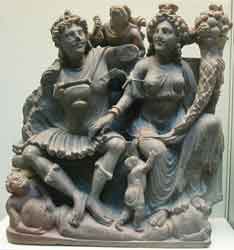
The Buddhist gods Pancika (left) and Hariti (right), 3rd century AD, Takht-i Bahi, Gandhara, British Museum.
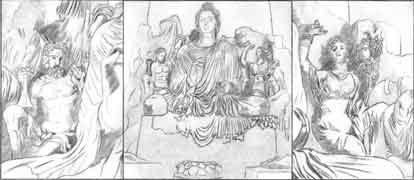
The Buddha with Herakles/Vajrapani (left detail) and Tyche/Hariti (right detail) may be "incipient Buddhist sculpture in Indo-Greek style" (Boardman). Herakles still has his lion skin on the left shoulder, although his club has been replaced by Vajrapani's thunderbolt. Tyche holds a Classical cornucopia, Tapa-i-Shotor, Hadda, eastern Afghanistan (Image Source).
Deities from the Greek mythological pantheon also tend to be incorporated in Buddhist representations, displaying a strong syncretism. In particular, Herakles (of the type of the Demetrius coins, with club resting on the arm) has been used abundantly as the representation of Vajrapani, the protector of the Buddha. Other Greek deities abundantly used in Greco-Buddhist art are representation of Atlas, and the Greek wind god. Atlas in particular tends to be involved as a sustaining elements in Buddhist architectural elements. The Greek wind god Boreas became the Japanese wind god Fujin through the Greco-Buddhist Wardo. The mother deity Hariti was inspired by Tyche.
Particularly under the Kushans, there are also numerous representations of richly adorned, princely Bodhisattvas all in a very realistic Greco-Buddhist style. The Bodhisattvas, characteristic of the Mahayana form of Buddhism, are represented under the traits of Kushan princes, completed with their canonical accessories.
Cupids
Winged cupids are another popular motif in Greco-Buddhist art. They usually fly in pair, holding a wreath, the Greek symbol of victory and kingship, over the Buddha.
These figures, also known as "apsarases" were extensively adopted in Buddhist art, especially throughout Eastern Asia, in forms derivative to the Greco-Buddhist representation. The progressive evolution of the style can be seen in the art of Qizil and Dunhuang. It is unclear however if the concept of the flying cupids was brought to India from the West, of if it had an independent Indian origin, although Boardman considers it a Classical contribution: "Another Classical motif we found in India is the pair of hovering winged figures, generally called apsaras." (Boardman)
Scenes of cupids holding rich garlands, sometimes adorned with fruits, is another very popular Gandharan motif, directly inspired from Greek art. It is sometimes argued that the only concession to Indian art appears in the anklets worn by the cupids. These scenes had a very broad influence, as far as Amaravati on the eastern coast of India, where the cupids are replaced by {{IAST|yakṣas.
Devotees
Some Greco-Buddhist friezes represent groups of donors or devotees, giving interesting insights into the cultural identity of those who participated in the Buddhist cult.
Some groups, often described as the "Buner reliefs," usually dated to the 1st century AD, depict Greeks in perfect Hellenistic style, either in posture, rendering, or clothing (wearing the Greek chiton and himation). It is sometimes even difficult to perceive an actual religious message behind the scenes. (The devotee scene on the right might, with doubt, depict of the presentation of Prince Siddharta to his bride. It may also just be a festive scene.)
About a century later, friezes also depict Kushan devotees, usually with the Buddha as the central figure.
Fantastic animals
temples, often triangular friezes in staircases or in front of Buddhist altars. The origin of these motifs can be found in Greece in the 5th century BC, and later in the designs of Greco-Bactrian perfume trays as those discovered in Sirkap. Among the most popular fantastic animals are tritons, ichthyo-centaurs and ketos sea-monsters.
As fantastic animals of the sea, they were, in early Buddhism, supposed to safely bring the souls of dead people to Paradise beyond the waters. These motifs were later adopted in Indian art, where they influenced the depiction of the Indian monster makara, Varuna's mount.
The Kushan contribution
The later part of Greco-Buddhist art in northwestern India is usually associated with the Kushan Empire. The Kushans were nomadic people who started migrating from the Tarim Basin in Central Asia from around 170 BC and ended up founding an empire in northwestern India from the 2nd century BC, after having been rather Hellenized through their contacts with the Greco-Bactrians, and later the Indo-Greeks (they adopted the Greek script for writing).
The Kushans, at the center of the Silk Road enthusiastically gathered works of art from all the quarters of the ancient world, as suggested by the hoards found in their northern capital in the archeological site of Begram, Afghanistan.
The Kushans sponsored Buddhism together with other Iranian and Hindu faiths, and probably contributed to the flourishing of Greco-Buddhist art. Their coins, however, suggest a lack of artistic sophistication: the representations of their kings, such as Kanishka, tend to be crude (lack of proportion, rough drawing), and the image of the Buddha is an assemblage of a Hellenistic Buddha statue with feet grossly represented and spread apart in the same fashion as the Kushan king. This tends to indicate the anteriority of the Hellenistic Greco-Buddhist statues, used as models, and a subsequent corruption by Kushan artists.
Southern influences of Greco-Buddhist art
The art of the Sunga
Examples of the influence of Hellenistic or Greco-Buddhist art on the art of the Sunga empire (183-73 BC) are usually faint. The main religion, at least at the beginning, seems to have been Brahmanic Hinduism, although some late Buddhist realizations in Madhya Pradesh as also known, such as some architectural expansions that were done at the stupas of Sanchi and Bharhut, originally started under King Ashoka.
This Sunga-period balustrate-holding Atalante Yaksa from the Sunga period (left), adopts the Atalante theme, usually fulfilled by Atlas, and elements of Corinthian capital and architecture typical of Greco-Buddhist friezes from the Northwest, although the content does not seem to be related to Buddhism. This work suggests that some of the Gandharan friezes, influential to this work, may have existed as early as the 2nd century or 1st century BC.
Other Sunga works show the influence of floral scroll patterns, and Hellenistic elements in the rendering of the fold of dresses. The 2nd century BC depiction of an armed foreigner (right), probably a Greek king, with Buddhist symbolism (triratana symbol of the sword), also indicates some kind of cultural, religious, and artistic exchange at that point of time.
The art of Mathura
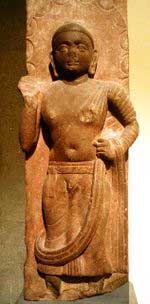
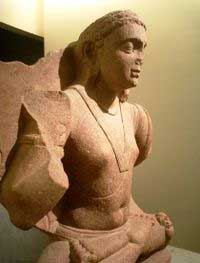
A Buddha, 2nd century, Mathura and The Bodhisattva Maitreya, 2nd century AD, Mathura.
The representations of the Buddha in Mathura, in central northern India, are generally dated slightly later than those of Gandhara, although not without debate, and are also much less numerous. Up to that point, Indian Buddhist art had essentially been aniconic, avoiding representation of the Buddha, except for his symbols, such as the wheel or the Bodhi tree, although some archaic Mathuran sculptural representation of Yaksas (earth divinities) have been dated to the first century BC. Even these Yaksas indicate some Hellenistic influence, possibly dating back to the occupation of Mathura by the Indo-Greeks during the 2nd century BC.
In terms of artistic predispositions for the first representations of the Buddha, Greek art provided a very natural and centuries-old background for an anthropomorphic representation of a divinity, whether on the contrary “there was nothing in earlier Indian statuary to suggest such a treatment of form or dress, and the Hindu pantheon provided no adequate model for an aristocratic and wholly human deity” (Boardman).
The Mathura sculptures incorporate many Hellenistic elements, such as the general idealistic realism, and key design elements such as the curly hair, and folded garment. Specific Mathuran adaptations tend to reflect warmer climatic conditions, as they consist in a higher fluidity of the clothing, which progressively tend to cover only one shoulder instead of both. Also, facial types also tend to become more Indianized.
The influence of Greek art can be felt beyond Mathura, as far as Amaravati on the East coast of India, as shown by the usage of Greek scrolls in combination with Indian deities. Other motifs such as Greek chariots pulled by four horses can also be found in the same area.
Incidentally, Hindu art started to develop from the 1st to the 2nd century AD and found its first inspiration in the Buddhist art of Mathura. It progressively incorporated a profusion of original Hindu stylistic and symbolic elements however, in contrast with the general balance and simplicity of Buddhist art.
Art of the Gupta
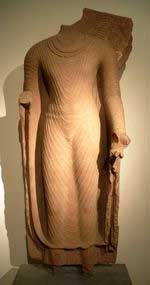
Buddha of the Gupta period, 5th century, Mathura.
The art of Mathura acquired progressively more Indian elements and reached a very high sophistication during the Gupta Empire, between the 4th and the 6th century AD. The art of the Gupta is considered as the pinnacle of Indian Buddhist art.
Hellenistic elements are still clearly visible in the purity of the statuary and the folds of the clothing, but are improved upon with a very delicate rendering of the draping and a sort of radiance reinforced by the usage of pink sandstone. Artistic details tend to be less realistic, as seen in the symbolic shell-like curls used to render the hairstyle of the Buddha.
Greco-Buddhist art expansion in Central Asia
Greco-Buddhist artistic influences naturally followed Buddhism in its expansion to Central and Eastern Asia from the 1st century BC.
Bactria
Bactria was under direct Greek control for more than two centuries from the conquests of Alexander the Great in 332 BC to the end of the Greco-Bactrian kingdom around 125 BC. The art of Bactria was almost perfectly Hellenistic as shown by the archaeological remains of Greco-Bactrian cities such as Alexandria on the Oxus (Ai-Khanoum), or the numismatic art of the Greco-Bactrian kings, often considered as the best of the Hellenistic world, and including the largest silver and gold coins ever minted by the Greeks.
When Buddhism expanded in Central Asia from the 1st century AD, Bactria saw the results of the Greco-Buddhist syncretism arrive on its territory from India, and a new blend of sculptural remained until the Islamic invasions.
The most striking of these realizations are the Buddhas of Bamiyan. They tend to vary between the 5th and the 9th century AD. Their style are strongly inspired by Hellenistic culture.
In another area of Bactria called Fondukistan, some Greco-Buddhist art survived until the 7th century in Buddhist monasteries, displaying a strong Hellenistic influence combined with Indian decorativeness and mannerism, and some influence by the Sasanid Persians.
Most of the remaining art of Bactria was destroyed from the 5th century onward: the Buddhist were often blamed for idolatry and tended to be persecuted by the iconoclastic Muslims. Destructions continued during the Afghanistan War, and especially by the Taliban regime in 2001. The most famous case is that of the destruction of the Buddhas of Bamiyan. Ironically, most of the remaining art from Afghanistan is the one that was removed from the country during the Colonial period. In particular, a rich collection exists at the Musee Guimet in France.
Tarim Basin
The art of the Tarim Basin, also called Serindian art, is the art that developed from the 2nd through the 11th century AD in Serindia or Xinjiang, the western region of China that forms part of Central Asia. It derives from the art of the Gandhara and clearly combines Indian traditions with Greek and Roman influences.
Buddhist missionaries travelling on the Silk Road introduced this art, along with Buddhism itself, into Serindia, where it mixed with Chinese and Persian influences.
See also: Silk Road transmission of Buddhism
Greco-Buddhist influences in Eastern Asia
The arts of China, Korea and Japan adopted Greco-Buddhist artistic influences, but tended to add many local elements as well. What remains most readily identifiable from Greco-Buddhist art are:
The general idealistic realism of the figures reminiscent of Greek art.
Clothing elements with elaborate Greek-style folds.
The curly hairstyle characteristic of the Mediterranean.
In some Buddhist representations, hovering winged figures holding a wreath.
Greek sculptural elements such as vines and floral scrolls.
China
Greco-Buddhist artistic elements can be traced in Chinese Buddhist art, with several local and temporal variations depending on the character of the various dynasties that adopted the Buddhist faith. Some of the earliest known Buddhist artifacts found in China are small statues on "money trees", dated circa 200 AD, in typical Gandharan style (drawing): "That the imported images accompanying the newly arrived doctrine came from Gandhara is strongly suggested by such early Gandhara characteristics on this "money tree" Buddha as the high ushnisha, vertical arrangement of the hair, moustache, symmetrically looped robe and parallel incisions for the folds of the arms." "Crossroads of Asia" p209
Some Northern Wei statues can be quite reminiscent of Gandharan standing Buddha, although in a slightly more symbolic style. The general attitude and rendering of the dress however remain. Other, like Northern Qi Dynasty statues also maintain the general Greco-Buddhist style, but with less realism and stronger symbolic elements.
Some Eastern Wei statues display Buddhas with elaborate Greek-style robe foldings, and surmounted by flying figures holding a wreath.
Japan
In Japan, Buddhist art started to develop as the country converted to Buddhism in 548 AD. Some tiles from the Asuka period, the first period following the conversion of the country to Buddhism, display a strikingly classical style, with ample Hellenistic dress and realistically-rendered body shape characteristic of Greco-Buddhist art.
Other works of art incorporated a variety of Chinese and Korean influences, so that Japanese Buddhist became extremely varied in its expression. Many elements of Greco-Buddhist art remain to this day however, such as the Hercules inspiration behind the Nio guardian deities in front of Japanese Buddhist temples, or representations of the Buddha reminiscent of Greek art such as the Buddha in Kamakura [5].
Various other Greco-Buddhist artistic influences can be found in the Japanese Buddhist pantheon, the most striking of which being that of the Japanese wind god Fujin. In consistency with Greek iconography for the wind god Boreas, the Japanese wind god holds above his head with his two hands a draping or "wind bag" in the same general attitude [6]. The abundance of hair have been kept in the Japanese rendering, as well as exaggerated facial features.
Another Buddhist deity, named Shukongoshin, one of the wrath-filled protector deities of Buddhist temples in Japan, is also an interesting case of transmission of the image of the famous Greek god Herakles to the Far-East along the Silk Road. Herakles was used in Greco-Buddhist art to represent Vajrapani, the protector of the Buddha, and his representation was then used in China and Japan to depict the protector gods of Buddhist temples [7].
Finally, the artistic inspiration from Greek floral scrolls is found quite literally in the decoration of Japanese roof tiles, one of the only remaining element of wooden architecture throughout centuries. The clearest one are from 7th century Nara temple building tiles, some of them exactly depicting vines and grapes. These motifs have evolved towards more symbolic representations, but essentially remain to this day in many Japanese traditional buildings [8].
Influences on South-East Asian art
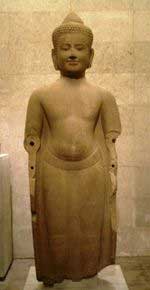

Cambodian Buddha, 14th century and Bodhisattva Lokesvara, Cambodia 12th century.
The Indian civilization proved very influential on the cultures of South-East Asia. Most countries adopted Indian writing and culture, together with Hinduism and Mahayana and Theravada Buddhism.
The influence of Greco-Buddhist art is still visible in most of the representation of the Buddha in South-East Asia, through their idealism, realism and details of dress, although they tend to intermix with Indian Hindu art, and they progressively acquire more local elements.
Cultural significance of Greco-Buddhist art
Beyond stylistic elements which spread throughout Asia for close to a millennium, the main contribution of Greco-Buddhist art to the Buddhist faith may be in the Greek-inspired idealistic realism which helped describe in a visual and immediately understandable manner the state of personal bliss and enlightenment proposed by Buddhism. The communication of deeply human approach of the Buddhist faith, and its accessibility to all have probably benefited from the Greco-Buddhist artistic syncretism.
Notes
- ↑ Standing Buddha:Image
- ↑ Standing Buddha:Image
- ↑ Belvedere Apollo: Image
- ↑ Vajrapani-Herakles:Image
- ↑ "Needless to say, the influence of Greek art on Japanese Buddhist art, via the Buddhist art of Gandhara and India, was already partly known in, for example, the comparison of the wavy drapery of the Buddha images, in what was, originally, a typical Greek style" (Katsumi Tanabe, "Alexander the Great, East-West cultural contacts from Greece to Japan", p19)
- ↑ "The Japanese wind god images do not belong to a separate tradition apart from that of their Western counter-parts but share the same origins. (...) One of the characteristics of these Far Eastern wind god images is the wind bag held by this god with both hands, the origin of which can be traced back to the shawl or mantle worn by Boreas/ Oado." (Katsumi Tanabe, "Alexander the Great, East-West cultural contacts from Greece to Japan", p21)
- ↑ "The origin of the image of Vajrapani should be explained. This deity is the protector and guide of the Buddha Sakyamuni. His image was modelled after that of Hercules. (...) The Gandharan Vajrapani was transformed in Central Asia and China and afterwards transmitted to Japan, where it exerted stylistic influences on the wrestler-like statues of the Guardian Deities (Nio)." (Katsumi Tanabe, "Alexander the Great, East-West cultural contacts from Greece to Japan", p23)
- ↑ The transmission of the floral scroll pattern from West to East is presented in the regular exhibition of Ancient Japanese Art, at the Tokyo National Museum.
| TIMELINE AND INFLUENCE OF GRECO-BUDDHIST ART | |||||
| Periods | Northern Asia | Central Asia | Gandhara | India | Southeast Asia |
| 5th century BC | Birth of Buddhism
|
||||
| 4th century BC | Occupation by Alexander the Great (330 BC)  |
||||
| 3rd-2nd century BC | Seleucid Empire (300-250BC) ---------- Greco-Bactrian kingdom (250-125 BC) (Hellenistic art)
|
Mauryan Empire (321-185 BC) (Aniconic art)
|
Introduction of Buddhism to Burma | ||
| 2nd-1st century BC | China, Han dynasty First mention of Buddhist statues brought from Central Asia (120 BC)
|
Indo-Greek kingdom (180 BC-10 AD) Buddhist symbolism and proselytism
|
Sunga Empire (185-73 BC)
|
||
| 1st century BC | Yuezhi Nomadic invaders, who became Hellenized and propagated Buddhism
|
Indo-Scythians (80-10 BC)
|
|||
| 1st century AD | Official start of Buddhism in China. Arrival of statues of the Buddha in 70 AD. | Indo-Parthians
|
Art of Mathura
|
||
| 1st-3rd century AD |  First known Buddha statues in China (later Han, c.200 AD) |
Kushan Empire (10-350 AD)
|
|||
| 4th-6th century AD | Tarim Basin China   Start of Buddhism in Japan |
Bactria  |
Gupta Empire (320-550 AD)
|
Mahayana Buddhism in Siam, Cambodia and Vietnam | |
| 7th-13th century AD | Japan  |
Islamic invasions | Pala Empire (11th century)  |
Southeast Asia  Introduction of Theravada from Sri Lanka in the 11th century |
|
See also
Links
References
- "Religions and the Silk Road" by Richard C. Foltz (St. Martin's Press, 1999) ISBN 0312233388
- "The Diffusion of Classical Art in Antiquity" by John Boardman (Princeton University Press, 1994) ISBN 0691036802
- "Old World Encounters. Cross-cultural contacts and exchanges in pre-modern times" by Jerry H.Bentley (Oxford University Press, 1993) ISBN 0195076397
- "Alexander the Great: East-West Cultural contacts from Greece to Japan" (NHK and Tokyo National Museum, 2003)
- "The Greeks in Bactria and India" W.W. Tarn, Cambridge University Press
- "Living Zen" by Robert Linssen (Grove Press New York, 1958) ISBN 0802131360
- "Echoes of Alexander the Great: Silk route portraits from Gandhara" by Marian Wenzel, with a foreword by the Dalai Lama (Eklisa Anstalt, 2000) ISBN 1588860140
- "The Crossroads of Asia. Transformation in Image and symbol", 1992, ISBN 0951839918
- "The Buddhist art of Gandhara", Sir John Marshall, 1960, ISBN 812150967X
| Ancient Greece
Science, Technology , Medicine , Warfare, , Biographies , Life , Cities/Places/Maps , Arts , Literature , Philosophy ,Olympics, Mythology , History , Images Medieval Greece / Byzantine Empire Science, Technology, Arts, , Warfare , Literature, Biographies, Icons, History Modern Greece Cities, Islands, Regions, Fauna/Flora ,Biographies , History , Warfare, Science/Technology, Literature, Music , Arts , Film/Actors , Sport , Fashion --- |
Retrieved from "http://en.wikipedia.org"
All text is available under the terms of the GNU Free Documentation License


 tl
tl








